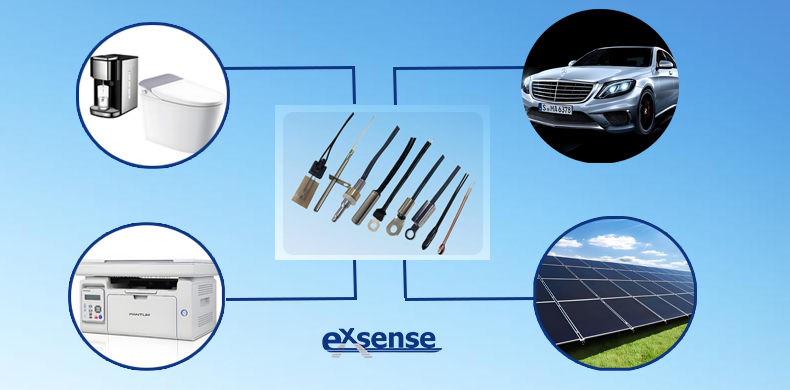NTC Temperature Sensors: Core Components Enabling Multi-Industry Innovation
As a core temperature-sensing element in modern electronic systems, NTC temperature sensors leverage their unique negative temperature coefficient and performance advantages to play a pivotal role across industries such as new energy vehicles, consumer electronics, automated office equipment, energy storage, and industrial control. This article provides a detailed analysis of NTC temperature sensors based on their nonlinear temperature response mechanism. It covers their working principles, multi-domain applications, and critical importance in real-world scenarios.
I. Working Principle of NTC Temperature Sensors
NTC temperature sensors are composed of thermistors with negative temperature coefficients, operating based on the thermosensitive properties of semiconductor materials. The core component is a thermistor whose resistance decreases as temperature rises. This sensitive resistance-temperature relationship enables NTC sensors to achieve precise temperature measurement and thermal control across diverse applications.
In NTC temperature sensors, thermistors are typically fabricated by blending transition metal oxides (e.g., manganese, cobalt, nickel, and copper) into a fluid-like clay matrix, followed by high-temperature sintering to form polycrystalline semiconductor materials. These materials exhibit exceptional stability and reliability in high-temperature environments, meeting demanding temperature measurement requirements in complex conditions.
When an NTC sensor contacts a target object, the thermistor detects temperature changes, causing its resistance to vary accordingly. The target’s temperature can be accurately calculated by measuring this resistance and referencing a predefined resistance-temperature curve. This method is prized for its simplicity, reliability, and high precision, making NTC sensors ubiquitous in industrial and consumer applications.
II. Multi-Domain Applications of NTC Temperature Sensors
1. Energy Vehicles
NTC temperature sensors are critical for temperature control and monitoring in electric vehicles. They ensure safe operation by tracking temperatures in battery packs, BMS (Battery Management Systems), OBC (On-Board Chargers), PDU (Power Distribution Units), drive motors, inverters, transformers, steering systems, and seat heaters.
2. Consumer Electronics
NTC temperature sensors enable intelligent thermal management in household devices such as coffee machines, smart toilets, bathtubs, water dispensers, water heaters, robotic vacuums, and steam ovens. Bullet-type NTC sensors, with rapid response times as fast as 0.3 seconds, optimize energy efficiency and enhance user comfort through real-time temperature adjustments.
3. Automated Office Equipment
NTC temperature sensors are indispensable in high-precision thermal management systems for office devices. For instance, high-speed laser printing modules employ miniaturized NTC sensor arrays to monitor multiple points on heat rollers, achieving dynamic control accuracy of ±0.5°C. This compensates for thermal inertia during toner fixation, ensuring consistent print quality.
4. Energy Storage Systems
NTC temperature sensors form multi-layered thermal safety frameworks for renewable energy systems, including wind turbine converters, photovoltaic inverters, and water-cooled energy storage battery stacks. They safeguard critical equipment and components from overheating.
5. Other High-Precision Fields
Aisheng Sensor sensors achieve temperature accuracies of ±0.5% to ±1%, meeting stringent demands in aerospace, high-speed rail, medical devices, and other precision-critical industries.
III. Conclusion
With their thermosensitive operating principles, NTC temperature sensors deliver rapid response, high reliability, and precision across industries such as new energy vehicles, consumer electronics, automated offices, and energy storage. Beyond real-time temperature monitoring, they enable intelligent adjustments to optimize device performance. As technology advances, NTC sensors will expand into new domains, driving innovation and enhancing convenience in daily life.














